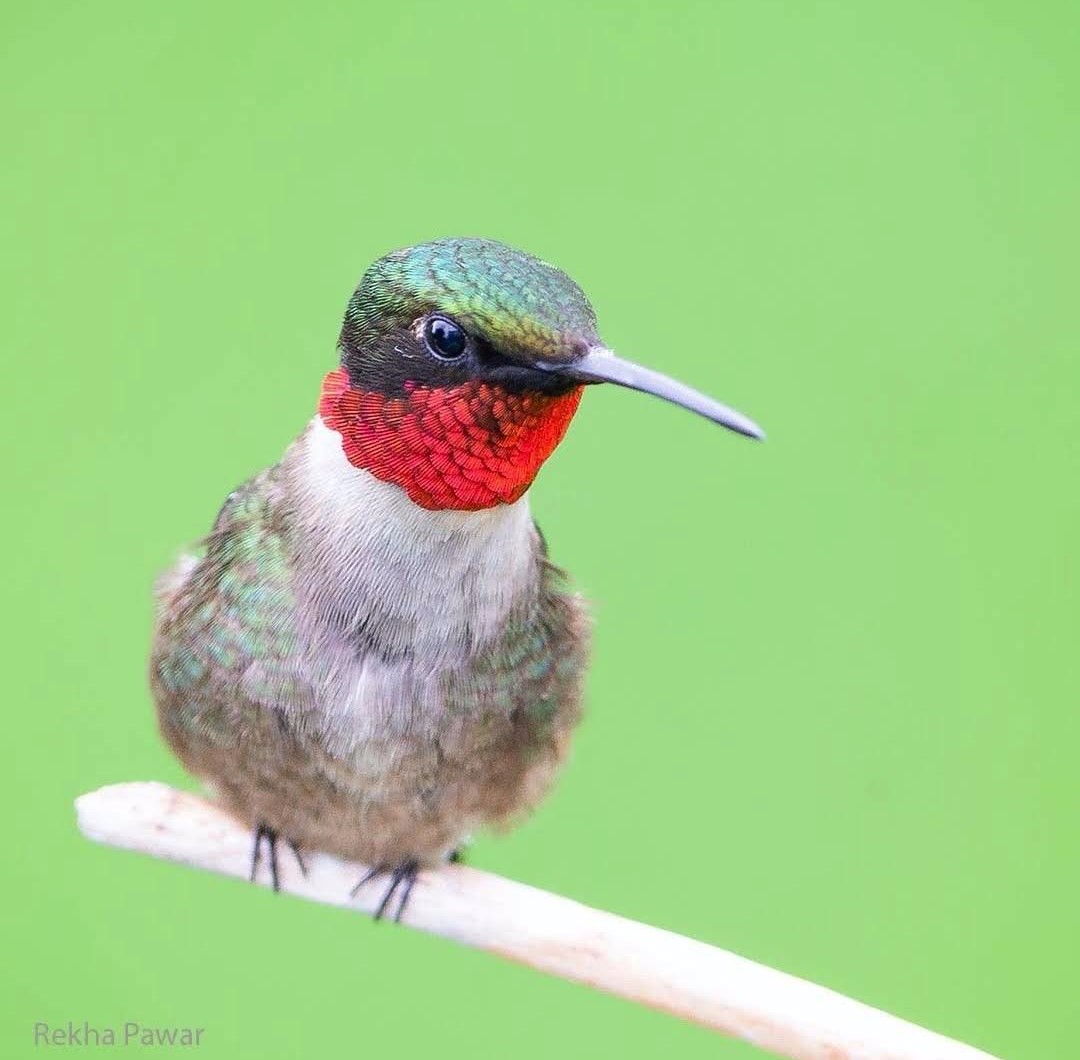This post contains affiliate links.
What types of hummingbirds are found in Pennsylvania?
There are 7 species of hummingbirds documented as seen in Pennsylvania:
- Allen’s
- Anna’s
- Bahama Woodstar
- Black-chinned
- Calliope
- Ruby-throated
- Rufous
These 7 hummingbird species found in Pennsylvania are further categorized into 3 groups: Year-round residents, seasonal, and rare/vagrants.
What are the most common hummingbirds seen in Pennsylvania?
The most common hummingbirds that are seen in Pennsylvania are the Ruby-throated hummingbirds representing 98.8% of all hummingbirds seen, followed by a distant second place by the Rufous hummingbird representing 0.61% of all hummingbirds seen in Pennsylvania.
The chart below shows hummingbird Pennsylvania sightings from the most to the least seen.
| Year-Round: | Out of 10,000 | Out of All |
| None | 0 | 0 |
| Seasonal: | ||
| Ruby-throated | 9,881 | 98.8% |
| Rufous | 61 | 0.61% |
| Vagrant: | ||
| Allen’s | 27 | 0.27% |
| Anna’s | 16 | 0.16% |
| Calliope | 9 | 0.09% |
| Black-chinned | 7 | 0.07% |
| Bahama Woodstar | Less than 1 | 0.004% |
Year-Round/Native Hummingbirds in Pennsylvania:
This hummingbird classification is defined as hummingbirds that are year-round residents residing in Pennsylvania 365 days a year and do not migrate.
There are no hummingbird species that is native to Pennsylvania and live there 365 days a year, however, the Calliope, Allen’s, Rufous, and Black-chinned hummingbirds have all been documented as present in Pennsylvania in the middle of the winter.
These wintering hummingbird sightings in Pennsylvania are reported by the Valley Forge Audubon Society.
The Calliope hummingbird was seen in November in Devon Pennsylvania and reportedly was the second Calliope to be sighted in Pennsylvania during the winter months.
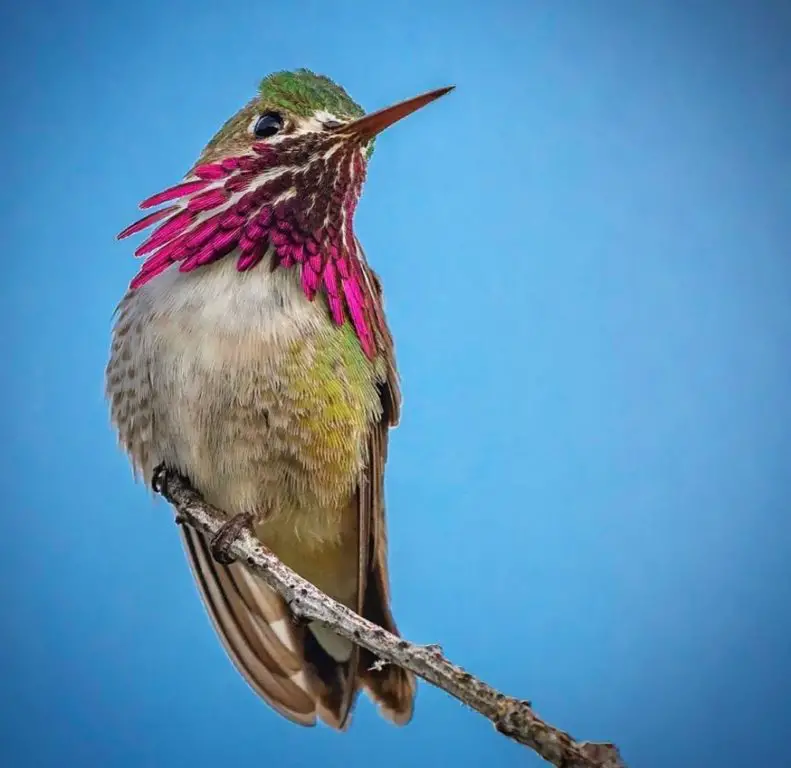
Photo by: sony_alpha_male

Photo by: sony_alpha_male
The Allen’s hummingbird was documented as being seen in Pennsylvania from November through early January in Pipersville Pennsylvania.

Photo by: IntheWildwithRick
The Valley Forge Audubon Society also reports the Rufous as a hummingbird species that is seen in Pennsylvania during the winter.
The Rufous hummingbird is the second most common hummingbird seen in Pennsylvania throughout the year.
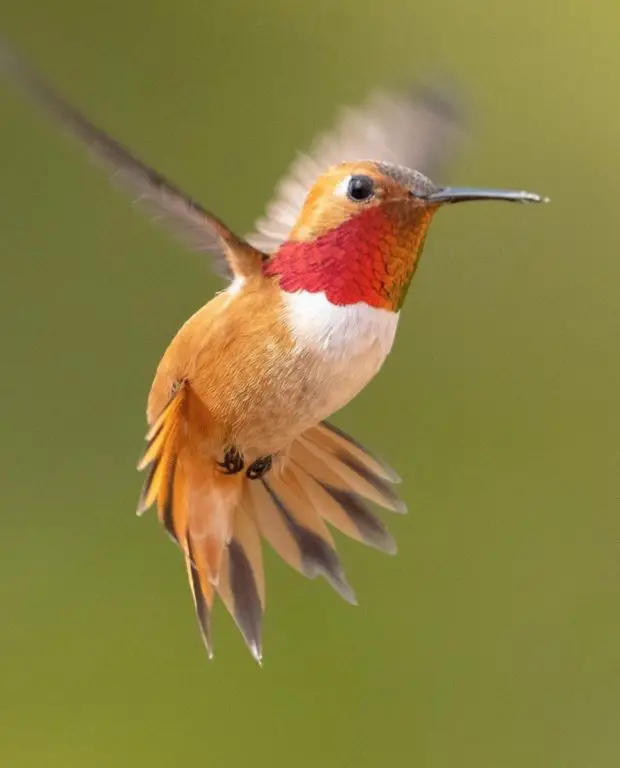
Photo by: jace_the_bird_nerd

Photo by: Rekha Pawar
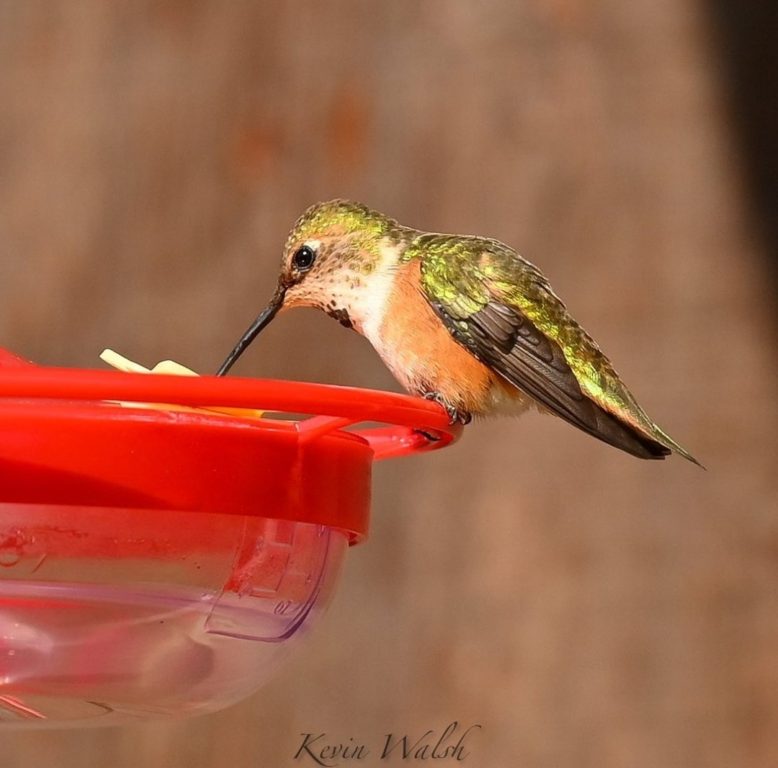
Photo by: Kevin Walsh
The Valley Forge Audubon Society also reports the very first sighting of a Black-chinned hummingbird during the winter months.
A picture of the wintering Black-chinned hummingbird was taken by a Buck’s county homeowner and verified by the Audubon Society.

Photo by: bird.whisperer
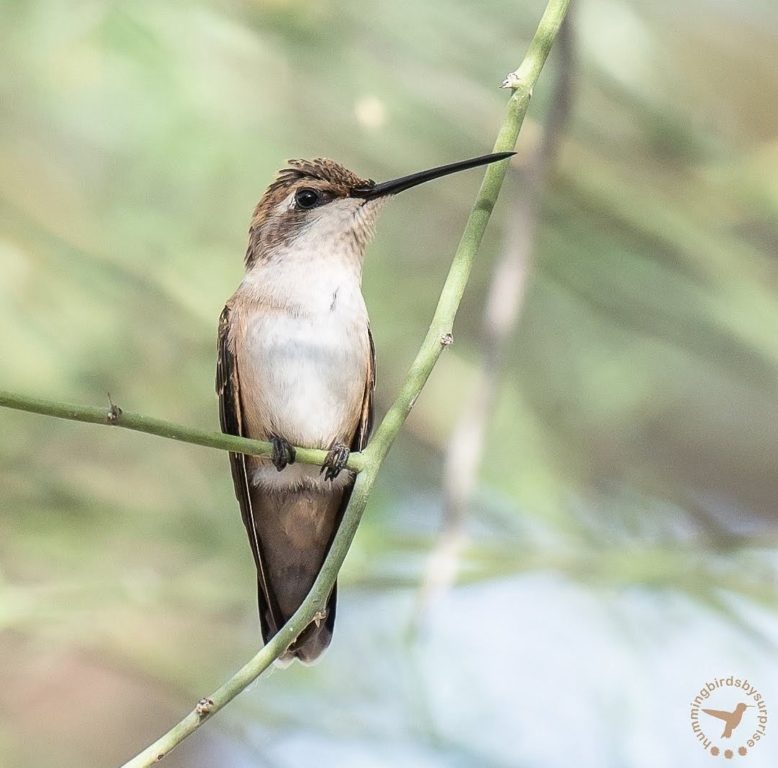
Photo by: hummingbirdsbysuprise
There are no year-round species of hummingbirds residing in Pennsylvania all 365 days a year, however, some cold-tolerant hummingbirds may over-winter on a year-by-year decision process.
Hummingbirds are much more tolerant of cold weather than most people would expect, especially the Ruby-throated and the Rufous hummingbirds, the two most common hummingbirds seen in Pennsylvania.
While the Rufous hummingbird has been documented in Pennsylvania during the winter months, the Ruby-throated hummingbird has not yet been documented as seen in winter.
According to eBird.org, some banded hummingbirds have been documented in temperatures of -9 degrees Fahrenheit with a wind chill of -36 degrees Fahrenheit.
Seasonal Hummingbirds in Pennsylvania:
This hummingbird classification is defined as hummingbirds that temporarily pass through Pennsylvania as part of their migratory pattern during spring and fall migration.
Hummingbirds travel north to breed during spring migration and travel south during fall migration to winter in Mexico and Central America.
The two hummingbirds seen in Pennsylvania that are classified as seasonal are:
- Ruby-throated
- Rufous
Below are the seasonal Pennsylvania hummingbird sightings listed from the most to the least seen.
RUBY-THROATED HUMMINGBIRD – (Archilochus colubris)
Conservation Status: Least concerned
Kingdom: Animalia
Phylum: Chordata
Class: Aves
Order: Apodiformes
Family: Trochilidae
Genus: Archilochus
Species: A. colubris
Ruby-throated hummingbirds dominate Eastern North America and are the most commonly seen in Pennsylvania.
On average, out of 10,000 hummingbirds, Pennsylvanians will see 9,881 Ruby-throated hummingbirds. Out of all hummingbird sightings in Pennsylvania, 98.8% will be Ruby-throated hummingbirds.
Ruby-throated hummingbird sightings are evenly distributed throughout the entire state of Pennsylvania.
See Pennsylvania Ruby-throated sightings map
Many of the Ruby-throated hummingbirds will not migrate further north than Pennsylvania and will remain in Pennsylvania all summer until they migrate south for the winter.
The Ruby-throated hummingbird’s scientific name originated from Carl Linnaeus, a Swedish botanist, who first listed this scientific classification as “Trochilus colubris”. Its name changed over a hundred years later and was reclassified by Ludwig Reichenbach, a German botanist, to “Archilochus colubris”, which is its current scientific name, meaning “top thief” or “sky spirit/sun-god bird”.
Male Ruby-throated hummingbirds have a striking iridescent blood-red gorget, stopping at the neckline. He is identified with a dull metallic green topside, a light gray underbelly, and black wings. The Ruby-throated hummingbird is a smaller species of hummingbird weighing less than 4.5 grams or 2 U.S. dimes and is 2.8 to 3.3 inches in length. Their lifespan is approximately 3-5 years.
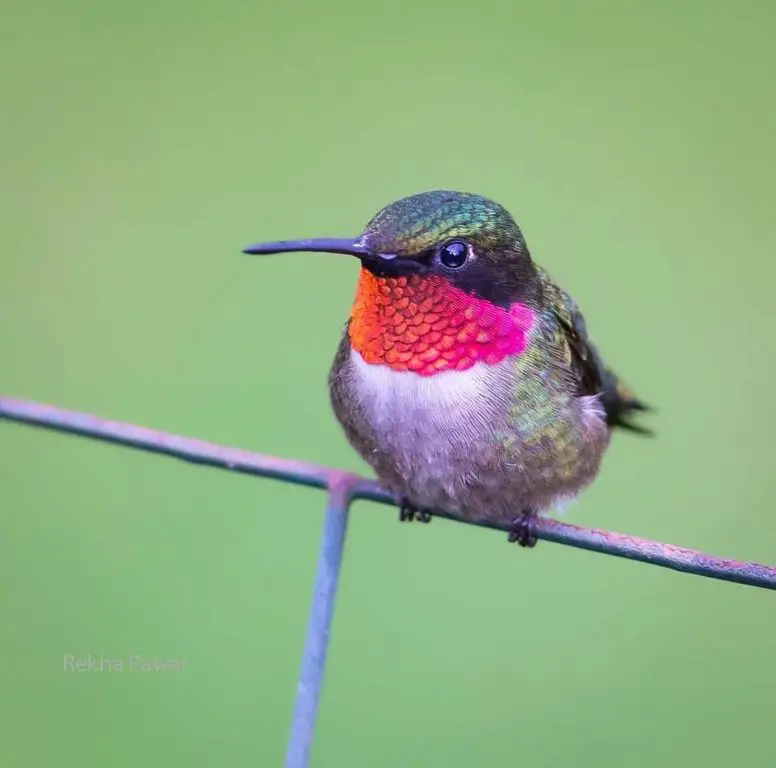
Photo by: Rekha Pawar

Photo by: dgen.photos

Photo by: paulapaintsart
Female Ruby-throated hummingbirds have a white throat with some light stippling and are typically larger than the males. The oldest female Ruby-throated hummingbird has been recorded at 9 years, almost double that of the male.
However, the average lifespan of a Ruby-throated hummingbird is approximately 3-5 years.

Photo by: Dgen.photos
Note: The pollen on her head and beak. This female Ruby-throated hummingbird has been busy pollinating and drinking nectar from flowers to sustain her high metabolism.
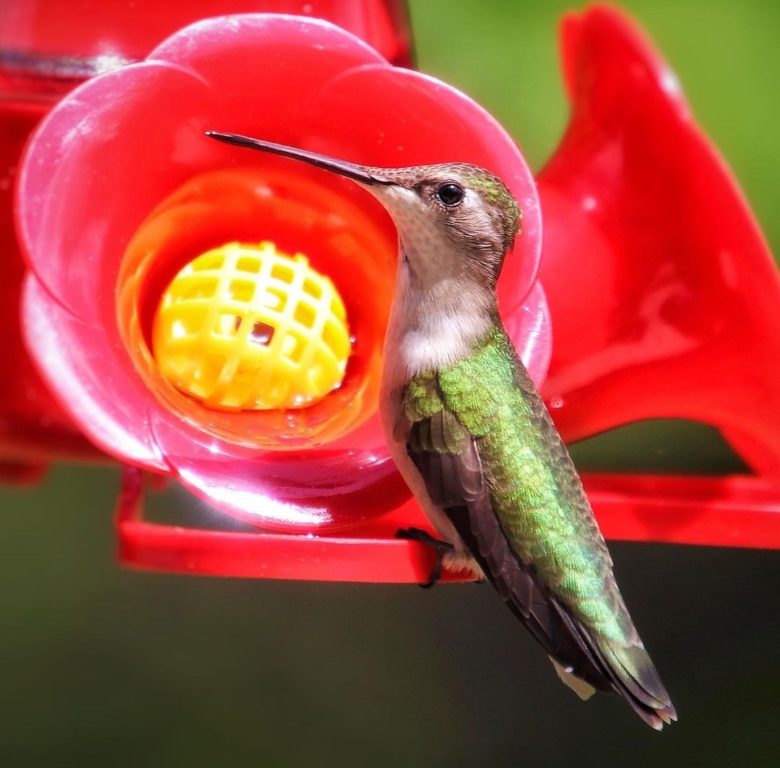
Photo by: paulapaintsart
The Ruby-throated hummingbird is the only hummingbird that breeds and nests in Pennsylvania, even though it is classified as a seasonal hummingbird.
See Ruby-throated breeding map
Juvenile male and female Ruby-throated hummingbirds, during their initial stages of life, resemble their mother, exhibiting a white throat with light stippling.
As the males mature, they begin to display a few specks of color near their neckline and eventually their bolder red throat feathers become more dominant and stately displaying a colorful gorget.
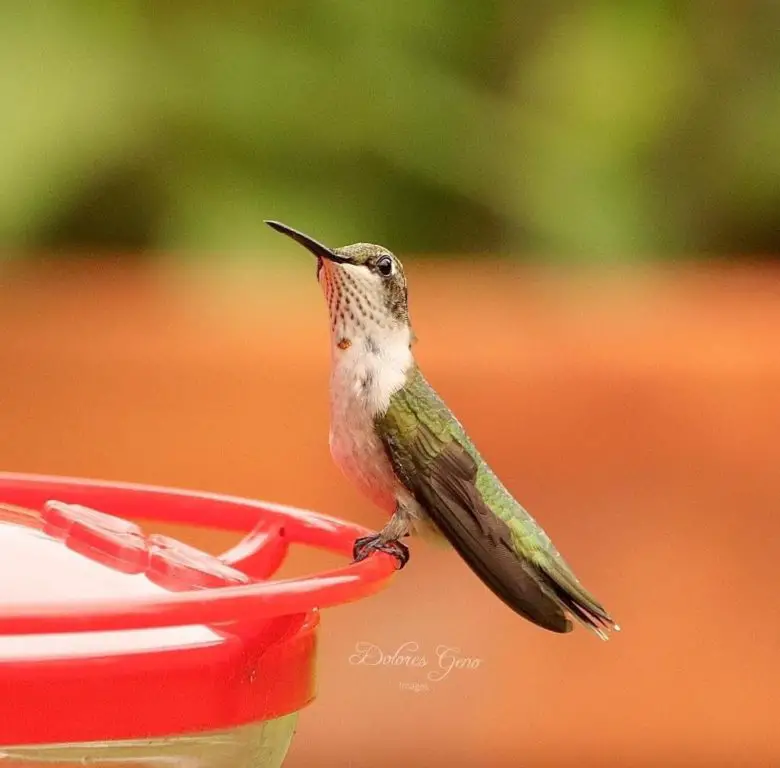
Photo by: Dgen.photos
Note: His throat feathers are slowly coming in, displaying a few dots of color near his neckline and showing the first stages of adolescence.
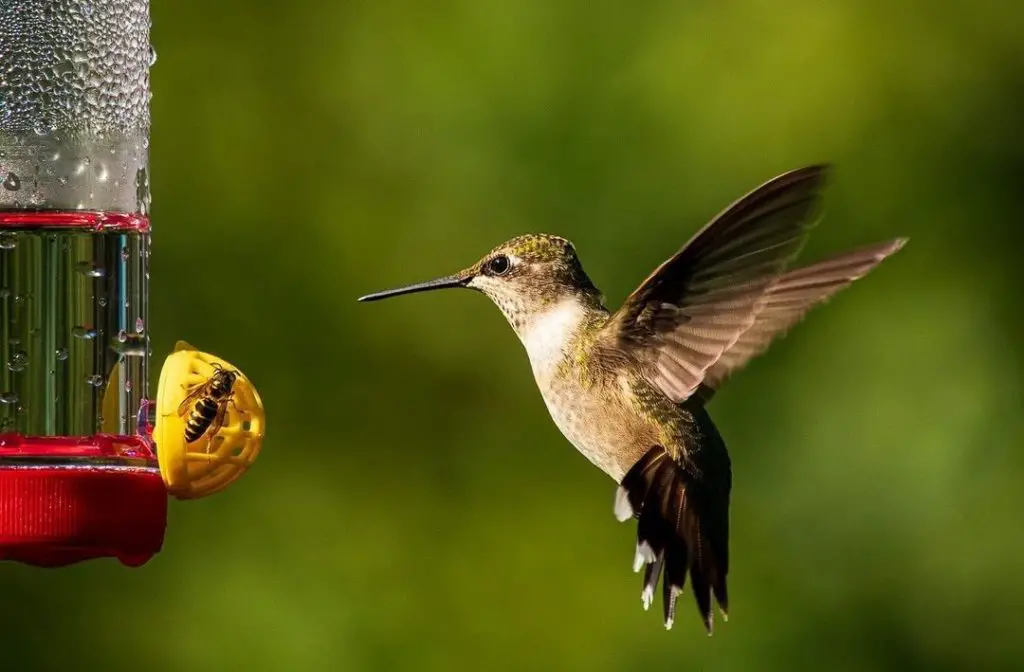
Photo by: MaryLou Ziebarth
Note: This juvenile Ruby-throated hummingbird is struggling with a bee or wasp situation at the feeder.
See my article: Bees On My Hummingbird Feeder: (9 Tips To Get Rid of Them)

Photo by: Dgen.photos
Note: These two juvenile Ruby-throated hummingbirds are playing nice and sharing a feeder. This could be because they are siblings or just getting the courage to find food on their own.
See my article: Why Hummingbirds Chase Each Other: Is it Friend or Foe?
Baby Ruby-throated hummingbirds are easily identified by their white fluffy feathers near their bottom that will disappear as they age.
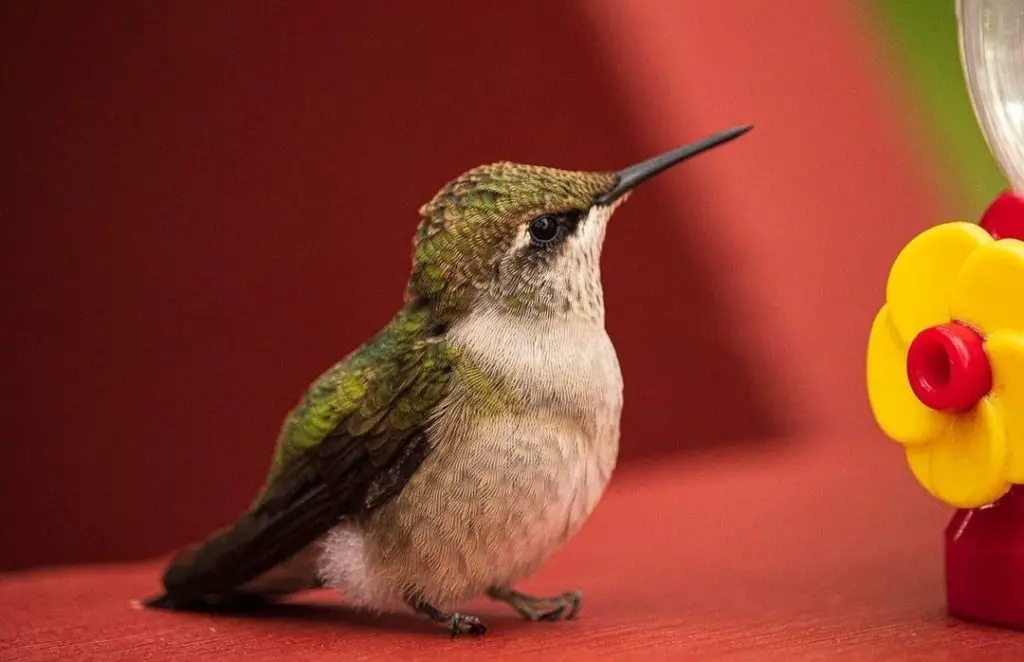
Photo by: MaryLou Ziebarth
Note: The newly white fluffy down feathers on this baby Ruby-throated hummingbird’s bottom. Also, notice the nice fat reserves they have accumulated by being fed by their diligent mother which will sustain them through adolescence.
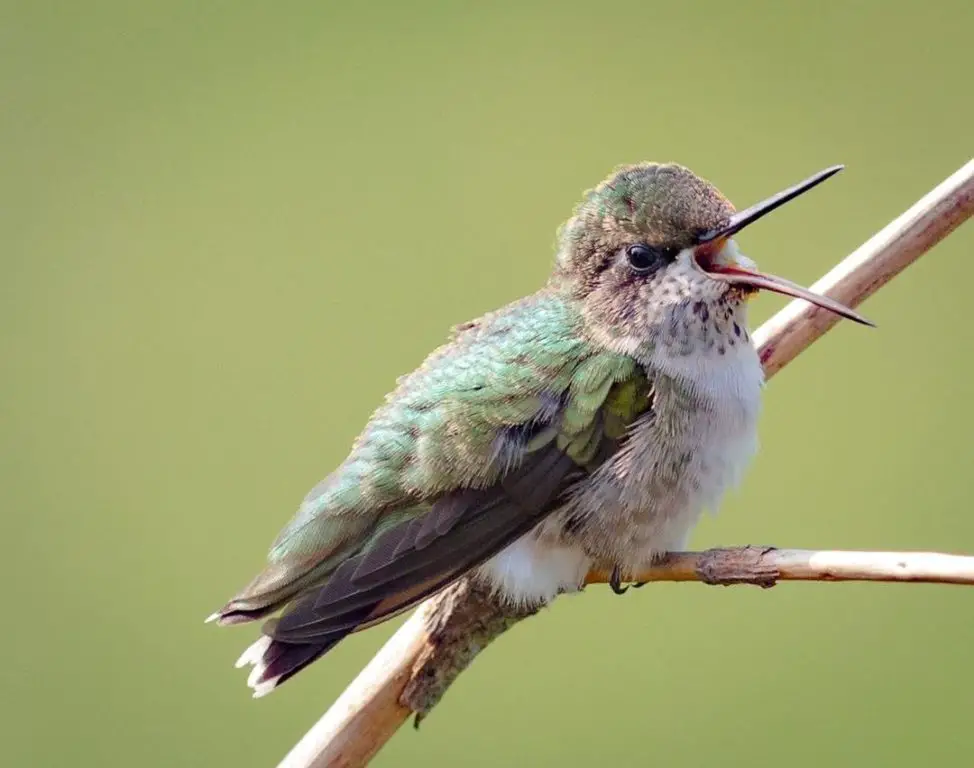
Photo by: Rekha Pawar
Hear the sounds of Ruby-throated hummingbirds
Many of the Ruby-throated hummingbirds will not migrate further north than Pennsylvania and will remain in Pennsylvania all summer until they migrate south for the winter
There are two migration routes for the Ruby-throated hummingbird during the spring and fall migrations.
The first migration route is a direct but exhausting nonstop journey southwest over the Gulf of Mexico to Mexico and then down to Central America for the winter. The flight distance over the Gulf of Mexico is over 500 miles.
The total direct flight from Philadelphia to Panama City, Panama is 2,149 miles.
Although this is the direct “short” route, there are numerous obstacles faced by these birds.
Some obstacles flying across the Gulf of Mexico include not being able to rest, having no means to refuel or eat, and having to avoid the dangerous tropical Atlantic hurricanes while flying to their destination. To make matters worse, depending on how you look at it, they migrate during the dark hours of the night or are taking the “Red-eye flight”.
Researchers believe their small size makes the energy expenditure of their grueling trans-oceanic migration pattern more taxing for males than for females even though they both double their body’s fat prior to making the migration across the Gulf of Mexico.
The second migration route, all over land, is 4,528 miles, flying along the coastline outlining the Gulf of Mexico. Although this is the “long” route, it allows the opportunity to rest and refuel even though there are fewer food source guarantees along the way.
Scientists are unclear and continue to investigate why one group of birds would prefer to take one route over the other.
See my article: Hummingbird Migration in Pennsylvania
Hummingbirds are much more tolerant of cold temperatures than most people realize.
According to eBird.org, through branding practices in Wisconsin, the Ruby-throated and Rufous hummingbirds have been documented surviving in temperatures of -9F and wind chills of -36F.
See my article: 3 Reasons Why Hummingbirds Are Banded
This selfless act also provides nectar to other migrating species unable to migrate because of injury or old age.
See my article: 11 DIY Ways to Keep Hummingbird Nectar From Freezing
Ruby-throated hummingbirds prefer open woodlands and are often seen in parks, gardens, and backyards. They are solitary birds except during mating periods when they are fiercely territorial and aggressive towards hummingbirds of other species.
Even though these hummingbirds have an aggressive side they can still be eaten by predators such as large invertebrates, praying mantises, orb-weaver spiders, and dragonflies.
See my article: 10 Common Things That Kill Hummingbirds
During a capture and release banding operation in West Virginia, the oldest living recorded female Ruby-throated hummingbird was 9 years and 1 month old.
See my article: 3 Reasons Why Hummingbirds Are Banded
RUFOUS HUMMINGBIRD – (Selasphorus rufus)
Conservation Status: Near threatened
Kingdom: Animalia
Phylum: Chordata
Class: Aves
Order: Apodiformes
Family: Trochilidae
Genus: Selasphorus
Species: S. rufous
Rufous hummingbirds are migratory birds and the second most commonly seen hummingbird in Pennsylvania. On average, out of 10,000 hummingbird sightings in Pennsylvania, 61 will be of the Rufous hummingbird. Out of all hummingbird sightings in Pennsylvania, 0.61% will be Rufous hummingbirds.
Sightings of Rufous hummingbirds in Pennsylvania are scattered throughout the state with concentrations in Harrisburg, Allentown, and Philadelphia areas as of this article’s posting date.
See current Pennsylvania Rufous sightings map
It is amazing to realize in comparing the top 2 commonly seen hummingbirds species in Pennsylvania out of 10,000 hummingbird sightings, 9,881 will be Ruby-throated while only 822 will be Rufous hummingbirds.
A far fewer number of Rufous hummingbirds will stay in Pennsylvania all summer on their spring northern migration, however, unlike the plentiful Ruby-throated hummingbirds, some Rufous hummingbirds have been documented as present in the Pennsylvania winter.
The Rufous hummingbird gets its name from the Latin word rubrum meaning “red” which is used to describe its reddish-brown coloring.
Male Rufous hummingbirds display an iridescent orange-red gorget with rusty-colored flanks and tail. They have a white-to-beige underbelly and a black bill. Males can also have green plumage with specks of green color on their rustic-looking backs or on the crown of their head along with chocolate brown dorsal feathers. Their size is 2.8 inches to 3.5 inches in length and weighs 3.2 grams.

Photo by: jace_the_bird_nerd
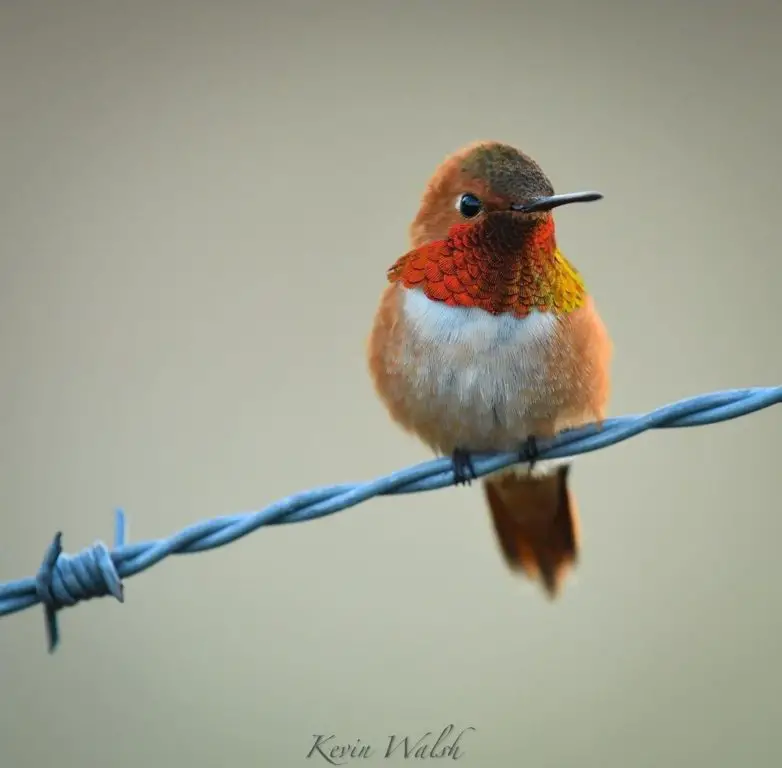
Photo by: Kevin Walsh
Note: The males iridescent orange-red gorget.
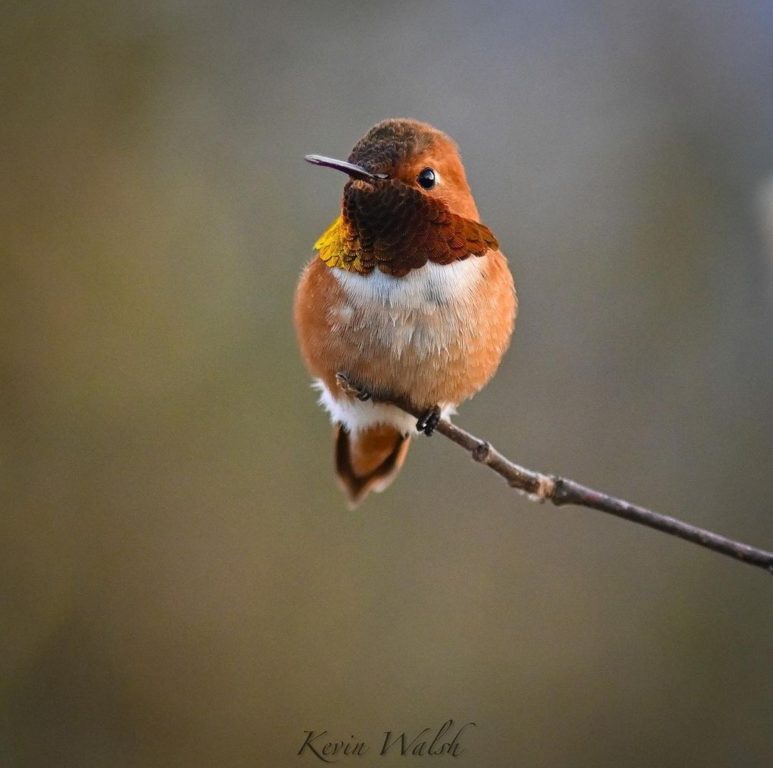
Photo by: Kevin Walsh
Note: The gorget appears chocolate brown in this lighting, however, you can still see a glimmer of his iridescent orange-red gorget with some hints of yellow.
Female Rufous hummingbirds have similar coloring as the males but do not have a gorget or iridescent feathers making them less vibrant. However, some females can have stippling or specs of color near their throat line looking similar to a juvenile which can cause confusion out in the field.
They are slightly larger than the males in anticipation of producing offspring.

Photo by: Kevin Walsh
They have one of the northernmost breeding ranges of any hummingbird in the world; migrating north from Mexico and nesting as far north as Alaska to breed during the summer months.
They are polygamous and will mate with several partners in a season.
See my article: Hummingbird Parents: (Mating to Nesting)
See my article: Baby Hummingbirds: (Egg to Fledgling)
Juvenile Rufous hummingbirds are so similar in coloring and temperament to Allen’s hummingbirds that they are practically indistinguishable in the field. Therefore, identification is established by range rather than appearance.
Juvenile male Rufous hummingbirds have a rustic look with small iridescent orange specks of color on their throats.

Photo by: Rekha Pawar
Note: His throat feathers are slowly coming in, displaying a few dots of color near his neckline and showing the first stages of adolescence.
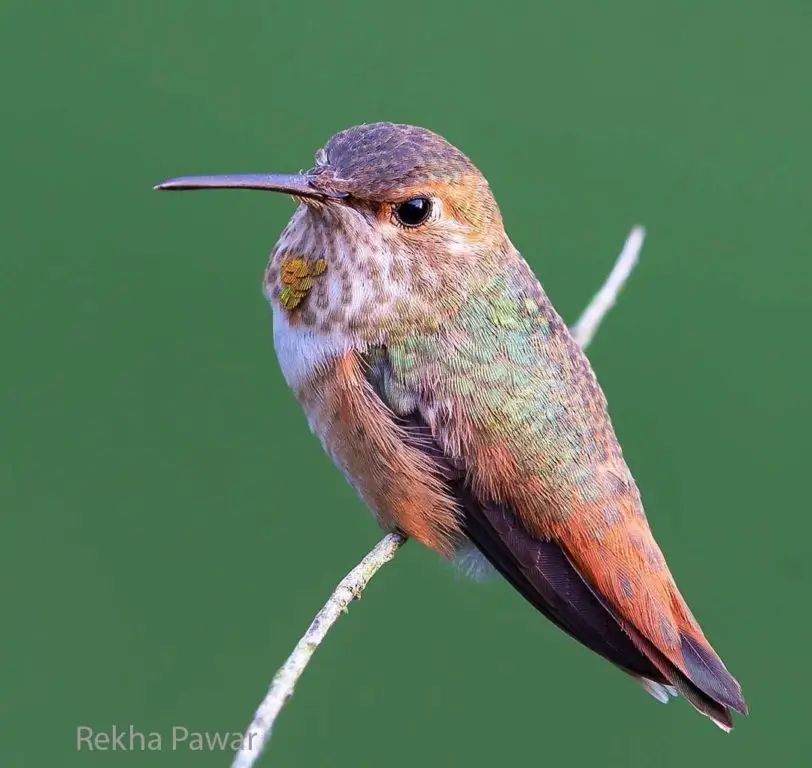
Photo by: Rekha Pawar
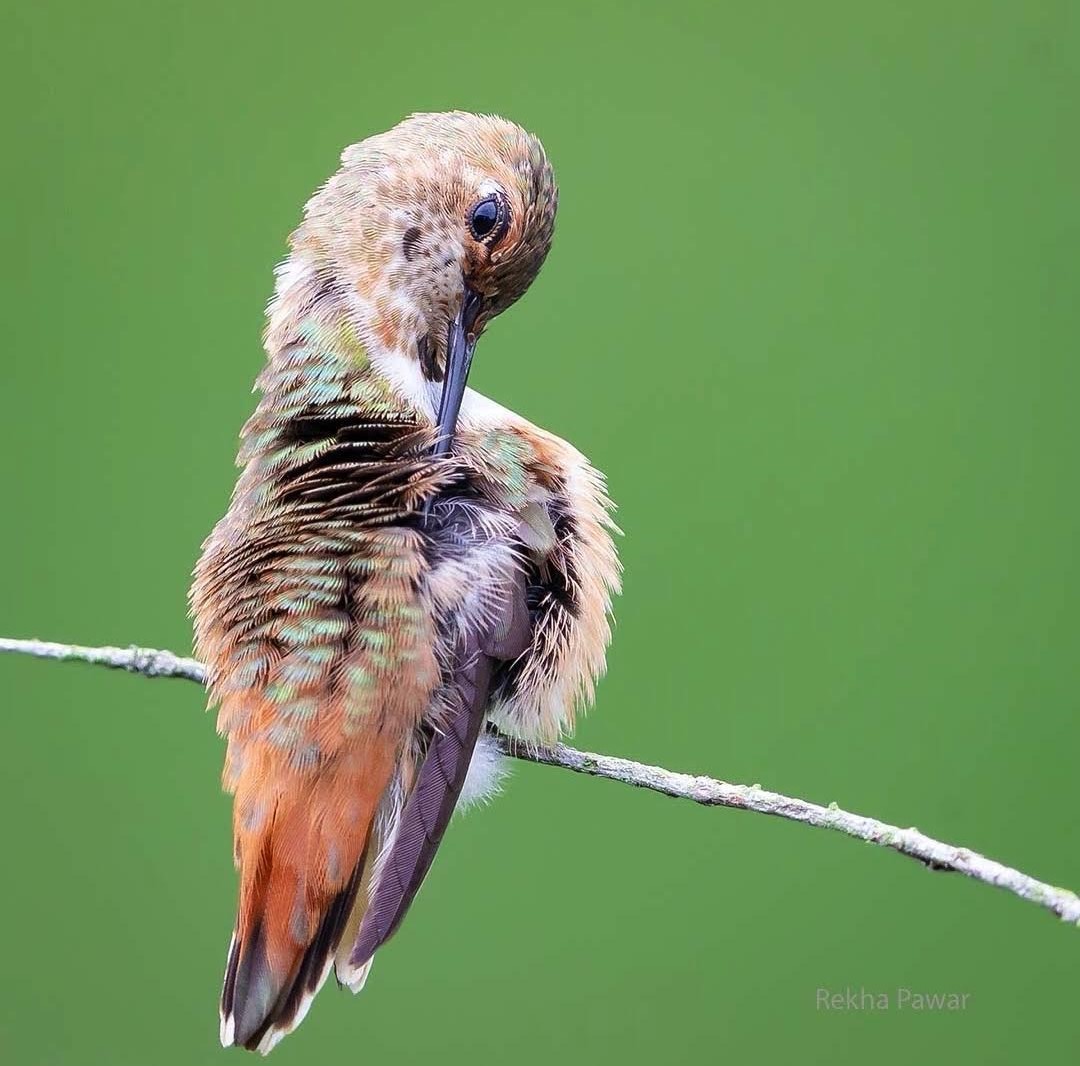
Photo by: Rekha Pawar
Note: Preening flight feathers is an important daily routine to maintain hygiene and to keep the feathers flexible, strong, in alignment, and parasite-free.
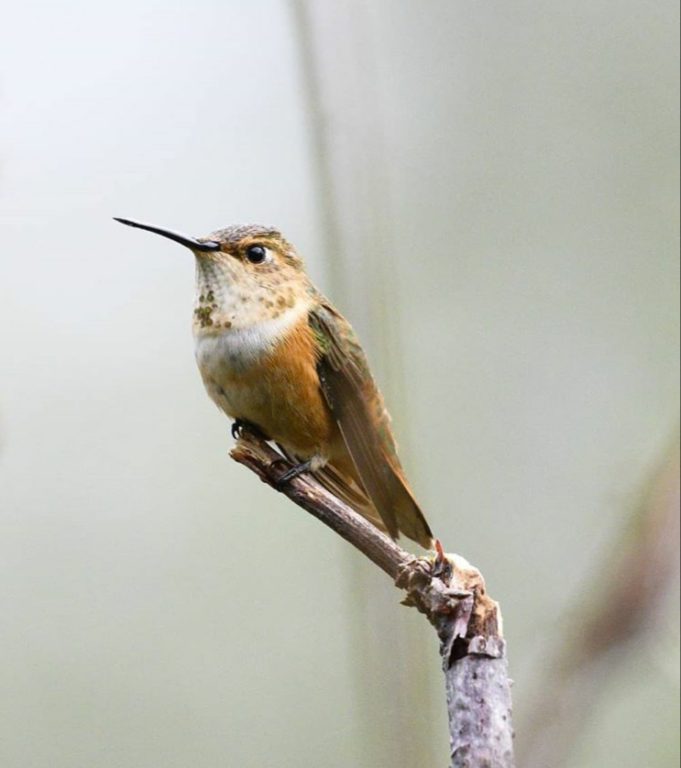
Photo by: Jace_the_bird_nerd
Baby Rufous hummingbirds are easily identified by their white fluffy feathers near their bottom that will disappear as they age.
Within the United States, Rufous hummingbirds make the longest migration of any bird in the world. They travel making a clockwise circuit of western America every year that is approximately 3,900 miles.
This migratory pattern during the seasons coordinates their arrival perfectly while catching nectar and blooming flowers throughout the year, fueling their bodies for their long journey.
Hummingbird enthusiasts are extremely valuable when they plant flowering plants to attract hummingbirds and provide feeders with homemade hummingbird nectar to contribute to a successful migration. These welcoming habitats provide and ensure safe travels as well as a reliable sanctuary for rest and refueling during their journey.
Most Rufous hummingbirds will not spend the winter in Pennsylvania and will decide to migrate south to Mexico. However, hummingbirds are much more tolerant of cold temperatures than most people realize.
According to eBird.org, through branding practices in Wisconsin, the Rufous and Ruby-throated hummingbirds have been documented surviving in temperatures of -9F and wind chills of -36F.
See my article: 3 Reasons Why Hummingbirds Are Banded
Some Pennsylvanian hummingbird admirers leave hummingbird feeders up all winter long to provide life-nourishing nectar. This selfless act also provides nectar to other injured or older hummingbirds that are unable to migrate.
See my article: 11 DIY Ways to Keep Hummingbird Nectar From Freezing
Rufous hummingbirds are highly territorial and aggressive towards other hummingbirds and animals. They are fearless and have a reputation for being feisty and chasing away not only other hummingbirds but even large birds and rodents from their favorite feeders.
The female mothers have been known to even attack squirrels and chipmunks that come too close to their nest.
Rufous hummingbirds have excellent memories and have been known to investigate the location of an old hummingbird feeder years after the feeder has been removed.
Their flying acrobatic skills can outmaneuver all other hummingbird species, making them extremely competitive at feeders.
Rufous hummingbirds hybridize and readily crossbreed with other hummingbird species, such as the Anna’s hummingbird.
Due to habitat loss in the Pacific Northwest, Rufous hummingbirds are listed at “near threatened” status by the IUCN red list of threatened species.
During a capture and release banding operation in British Columbia, the oldest living recorded female Rufous hummingbird was 8 years and 11 months.
See my article: 3 Reasons Why Hummingbirds Are Banded
Rare/Vagrant Hummingbirds in Pennsylvania:
This hummingbird classification is defined as hummingbirds residing in a group outside of their normal geographic range. Not only do these species of hummingbirds have a wide variety of specific geographic ranges, but they are also known to sometimes interbreed with each other creating hybrids.
These hummingbirds are out of their normal area of occupancy but have been documented as being seen in Pennsylvania.
The five hummingbirds seen in Pennsylvania that are classified as rare/vagrant are:
- Allen’s
- Anna’s
- Calliope
- Black-chinned
- Bahama Woodstar
Below are the rare/vagrant Pennsylvania hummingbird sightings from the most to the least seen.
ALLEN’S HUMMINGBIRD – (Selasphorus sasin)
Conservation Status: Least concerned
Kingdom: Animalia
Phylum: Chordata
Class: Aves
Order: Apodiformes
Family: Trochilidae
Genus: Selasphorus
Species: S. sasin
Allen’s hummingbirds are rare migratory visitors to Pennsylvania because they commonly reside and nest along the western coast of the United States, wintering in Mexico.
On average, out of 10,000 hummingbird sightings in Pennsylvania, only 27 will be of the Allen’s hummingbird. Out of all hummingbird sightings in Pennsylvania, 0.27% will be Allen’s hummingbirds.
These limited sightings of Allen’s hummingbird sightings in Pennsylvania are concentrated in the Hershey, Lancaster, and Philadelphia areas as of this article’s posting date.
See current Pennsylvania Allen’s sightings map
The common name of Allen’s hummingbird is in commemoration of Charles Andrew Allen (1841-1930), an American collector and taxidermist.
Male Allen’s hummingbirds are green-backed with a green forehead and rust-colored flanks, rump, and tail. When their tail feathers are fanned out you can see their chocolate-colored tips. The gorget of the male Allen’s hummingbird is an iridescent orange-red, however, in darker lighting, it can appear chocolate brown. Allen’s hummingbirds are 3.3 inches to 3.5 inches in length and weigh 2-4 grams.

Photo by: IntheWildwithRick
Note: The male’s iridescent orange-red gorget.
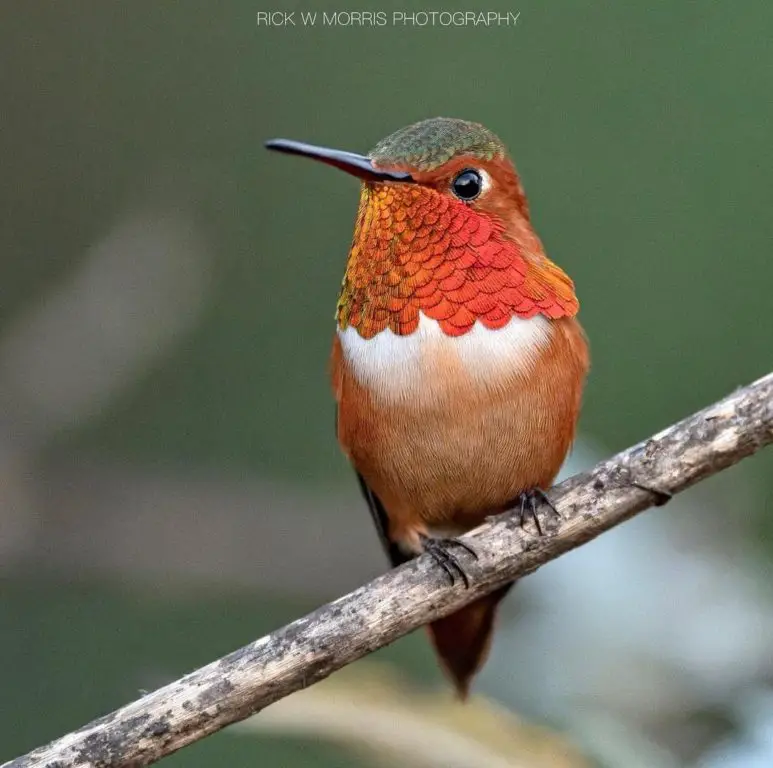
Photo by: IntheWildwithRick
Female Allen’s hummingbirds have similar coloring as the males but do not have a gorget or iridescent feathers making them less vibrant. However, some females can have stippling or specs of color near their throat line looking similar to a juvenile which can cause confusion out in the field.

Photo by: aarongomperts
See my article: Hummingbird Parents: (Mating to Nesting)
See my article: Baby Hummingbirds: (Egg to Fledgling)
Allen’s hummingbirds commonly reside and nest along the west coast and winter in Mexico. Their nesting season is perfectly timed with when the regions have the most rainfall which helps provide prolific nectar-producing flowers for their offspring.
Juvenile Allen’s hummingbirds, both male, and female look more like adult females until they are differentiated as the male begins to acquire the iridescent feathers that are typical of this species of hummingbird.
They are so similar in coloring and temperament to a Rufous hummingbird that they are practically indistinguishable in the field. Therefore, identification is established by range rather than appearance.

Note: The gorget can appear chocolate brown in certain lighting. Also, notice there are still white fluffy down feathers near his bottom suggesting he is not a full adult, however, is in the late stages of adolescence.

Note: This juvenile/baby male Allen’s hummingbird is on a tomato cage defending a feeder.
Notice there are still white fluffy down feathers near his bottom as well as some stippling around his throat. A full gorget has not matured, suggesting he is in the early stages of adolescence.
Baby Allen’s hummingbirds are easily identified by their white fluffy feathers near their bottom that will disappear as they age.
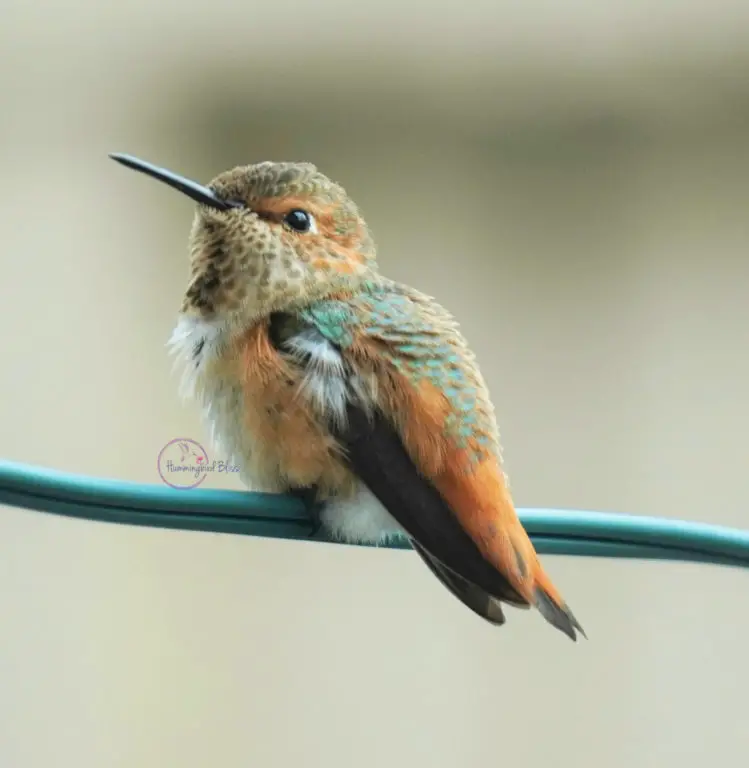
Note: He is diligently defending a nearby feeder.
Notice the difference in stages of maturing from the last photo on a tomato cage [an older juvenile] to the present photo on an outside light wire [a young baby]. They both have white fluffy feathers near their bottoms, however, you can clearly see an age difference between youth to more mature.

Note: On a tomato cage; hiding in a tomato plant near a feeder.
Male Allen’s hummingbirds perform a striking, quick back-and-forth courtship dance resembling the movement of a pendulum. They have one of the most complex territorial dive displays of any North American hummingbird.
See my article: Hummingbird Dance: 5 Interpretive Explanations
Male and female Allen’s hummingbirds are not social birds. They do not associate with one another outside of breeding. Similar to a Rufous hummingbird, Allen’s hummingbirds are highly territorial and aggressive towards other hummingbirds and larger predatory birds such as hawks.
During a capture and release banding operation in California, the oldest living recorded Allen’s hummingbird was 5 years and 11 months old when she was first captured in 2004 and again in 2009.
See my article: 3 Reasons Why Hummingbirds Are Banded
ANNA’S HUMMINGBIRD – (Calypte anna)
Conservation Status: Least concerned
Kingdom: Animalia
Phylum: Chordata
Class: Aves
Order: Apodiformes
Family: Trochilidae
Genus: Calypte
Species: C. anna
Anna’s hummingbirds are predominately a west coast bird found all along the California, Oregon, and Washington coasts and all the way up to Alaska and Canada making them rare in Pennsylvania.
On average, out of 10,000 hummingbird sightings in Pennsylvania, 16 will be of Anna’s hummingbirds. Out of all hummingbird sightings in Pennsylvania, 0.16% will be Anna’s hummingbirds.
These limited sightings of Anna’s hummingbird sightings in Pennsylvania are concentrated in the Yorko, Wilmington, and Philadelphia areas as of this article’s posting date.
See current Pennsylvania Anna’s sightings map
Anna’s hummingbirds are named after Anna Massena, Duchess of Rivoli. They are the only hummingbirds to stay year-round on the Pacific Coast. These hummingbirds live in a Mediterranean climate with moderate wet winters and hot dry summers.
Male Anna’s hummingbirds are the only hummingbird species in North America with a red crown. They are identified as mostly green, gray, and magenta in color. The males have a flashy and colorful iridescent magenta gorget and crown. Their size ranges from 3.5 inches to 4.3 inches in length and they weigh 2.4 to 4.5 grams.
The gorget on a male hummingbird is named after the protective metal piece in a suit of armor that covers the wearer’s throat to prevent injury when in battle. Since male hummingbirds are very aggressive with each other when fighting for their own territory, this name is appropriate and fitting to describe their physical attributes.
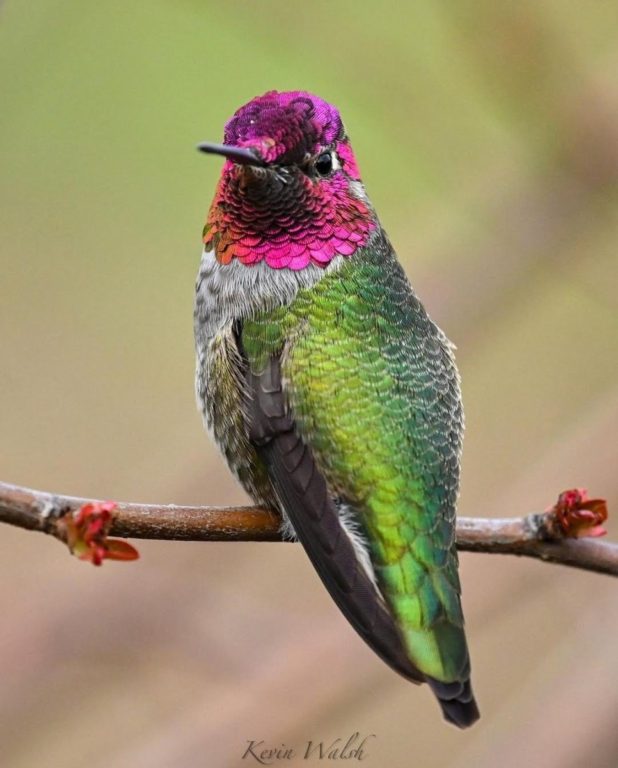
Photo by: Kevin Walsh
Note: The iridescent magenta gorget and crown with a metallic green shiny back.
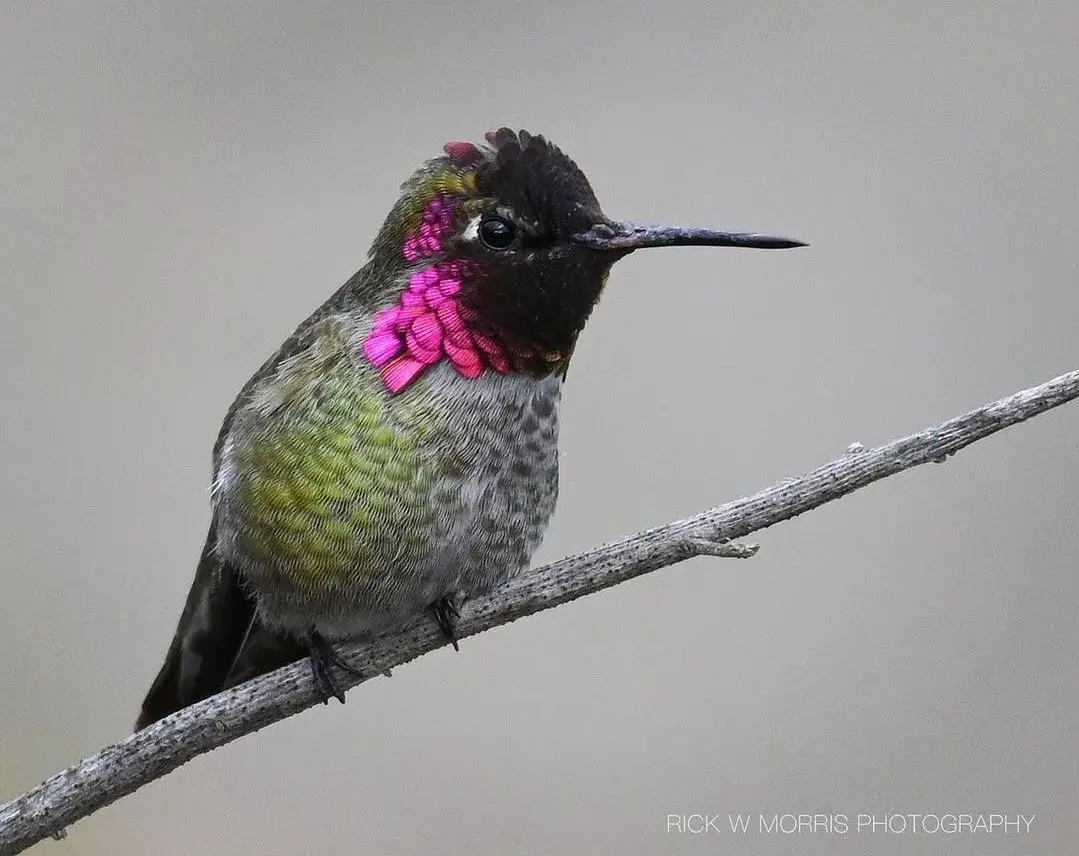
Photo by: IntheWildwithRick
Female Anna’s hummingbirds are overall not as colorful as the males, appearing pale green in color. Females can also have a gorget, but it is a smaller patch of magenta. Females tend to have a pale white line over each eye that makes them distinctive.
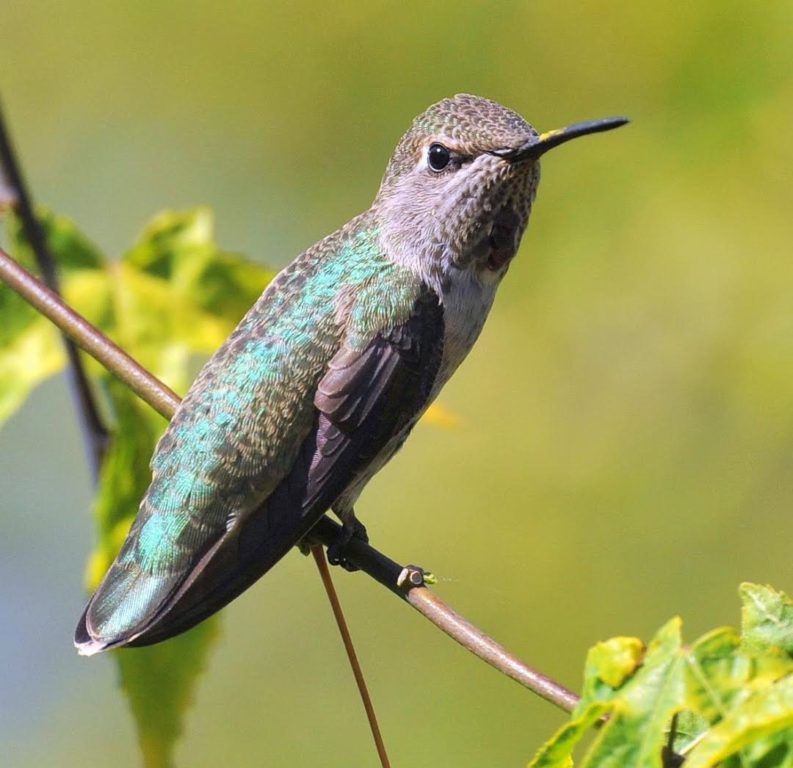
Photo by: IntheWildwithRick
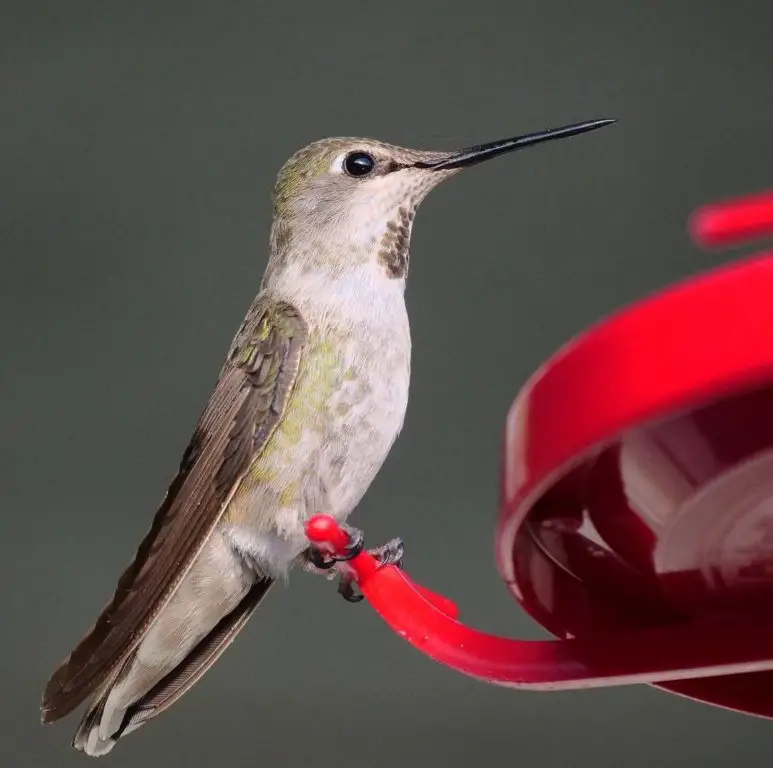
Photo by: Kevin Walsh

Photo by: Mehta.vishal.360
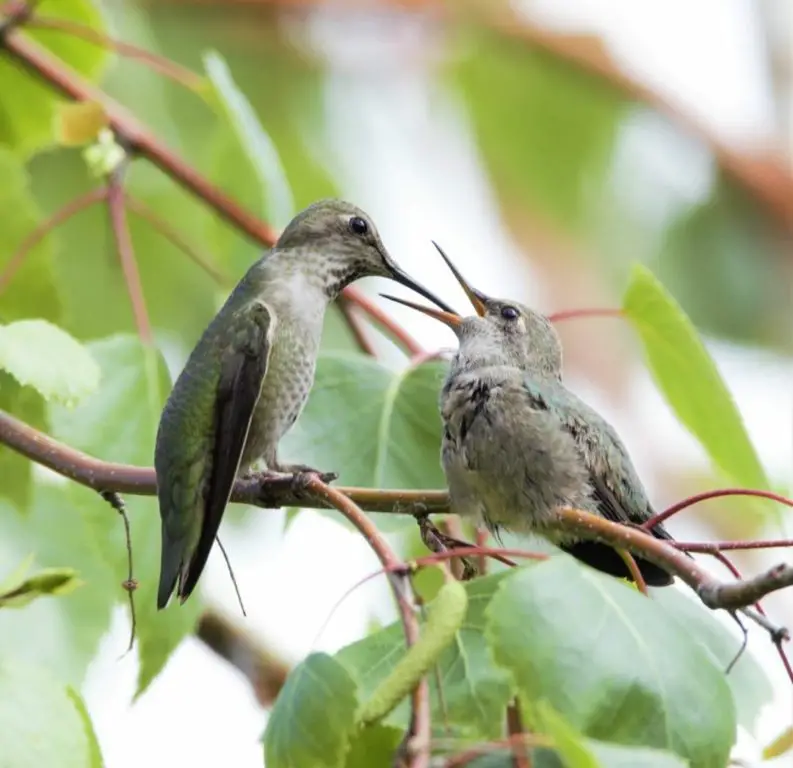
Photo by: Mehta.vishal.360
Female Anna’s hummingbirds raise their young with no help from the males.
See my article: Hummingbird Parents: (Mating to Nesting)
See my article: Baby Hummingbirds: (Egg to Fledgling)
Juvenile Anna’s hummingbirds, both male, and female look more like adult females until they are differentiated as the male begins to acquire the bright red/magenta gorget.

Photo by: Kevin Walsh
Note: This Anna’s hummingbird could be a juvenile in those awkward teenage years or it could be during a molting stage.
Baby Anna’s hummingbirds are easily identified by their white fluffy feathers near their bottom that will disappear as they age.
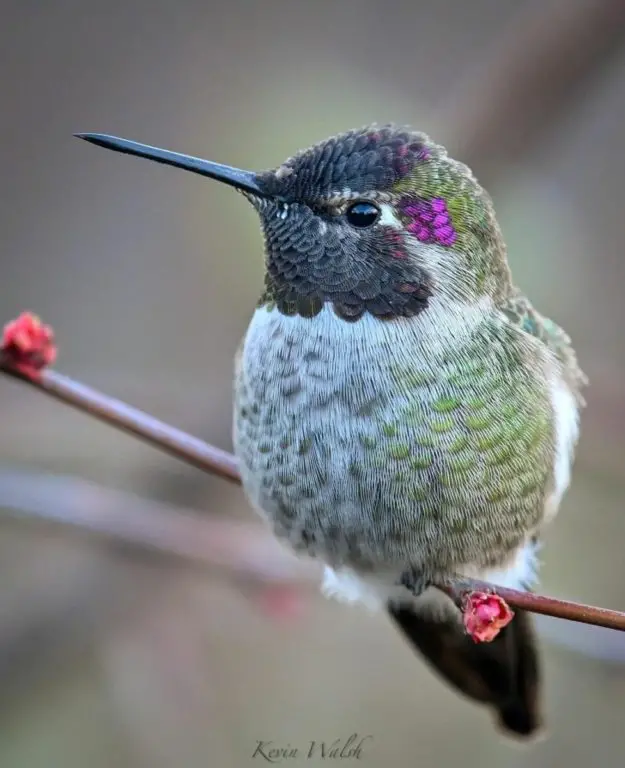
Photo by: Kevin Walsh
Note: This baby/juvenile male Anna’s hummingbird is beginning to show his magenta head feathers near his temple along with some faint color starting to show on his gorget. Also, notice the newly white fluffy down feathers near his bottom as well as the nice fat reserves he has accumulated by being fed by his diligent mother.

Photo by: Kevin Walsh
The courtship and dive displays performed by Anna’s hummingbirds are theatrical and entertaining. From the beginning to the end, the full dive display lasts 12 seconds.
See my article: Hummingbird Dance: 5 Interpretive Explanations
Unlike many northern temperate hummingbirds, male Anna’s hummingbirds sing during courtship along with making vibrations with their tail feathers to attract a female.
Anna’s hummingbirds protect their territory with elaborate dives targeted toward predatory birds and even toward people they perceive to be threatening.
They hybridize and readily crossbreed with other hummingbird species, such as the Black-chinned, Costa’s, and Rufous hummingbirds.
During a capture and release banding operation in Arizona, the oldest living recorded male Anna’s hummingbird was 8 years and 2 months.
See my article: 3 Reasons Why Hummingbirds Are Banded
CALLIOPE HUMMINGBIRD – (Selasphorus calliope)
Conservation Status: Least concerned
Kingdom: Animalia
Phylum: Chordata
Class: Aves
Order: Apodiformes
Family: Trochilidae
Genus: Selasphorus
Species: S. calliope
Calliope hummingbirds are a migrating species and are seen mainly in the Western United States, therefore making them a rare visitor to Pennsylvania.
On average, out of 10,000 hummingbird sightings in Pennsylvania, 9 will be of the Calliope hummingbird. Out of all hummingbird sightings in Pennsylvania, 0.09% will be Calliope hummingbirds.
These limited sightings of Calliope hummingbird sightings in Pennsylvania are concentrated in the Harrisburg, Lancaster, and Philadelphia areas as of this article’s posting date.
See current Pennsylvania Calliope sightings map
Calliope hummingbirds are named after a Greek mythological muse, who represented poetry and eloquence. Calliope means “beautiful voice” in ancient Greek.
Male Calliope hummingbirds are easily identified by their iridescent purple crown and long striking spaced outline row of feathers that project down the sides of their throat. Like many hummingbirds, the backs are metallic green and these birds measure 3 inches in length and weigh 2-3 grams.

Photo by: sony_alpha_male
Female Calliope hummingbirds do not have a gorget or iridescent feathers and are less vibrant than the males. The crown or the top of their head is gray-green in color. The flanks which are the sides and underbelly or behind the wings are buff in color.

Photo by: sony_alpha_male
Juvenile Calliope hummingbirds, both male, and female look more like adult females until they are differentiated as the male begins to acquire the iridescent feathers that are typical of this species of hummingbird.
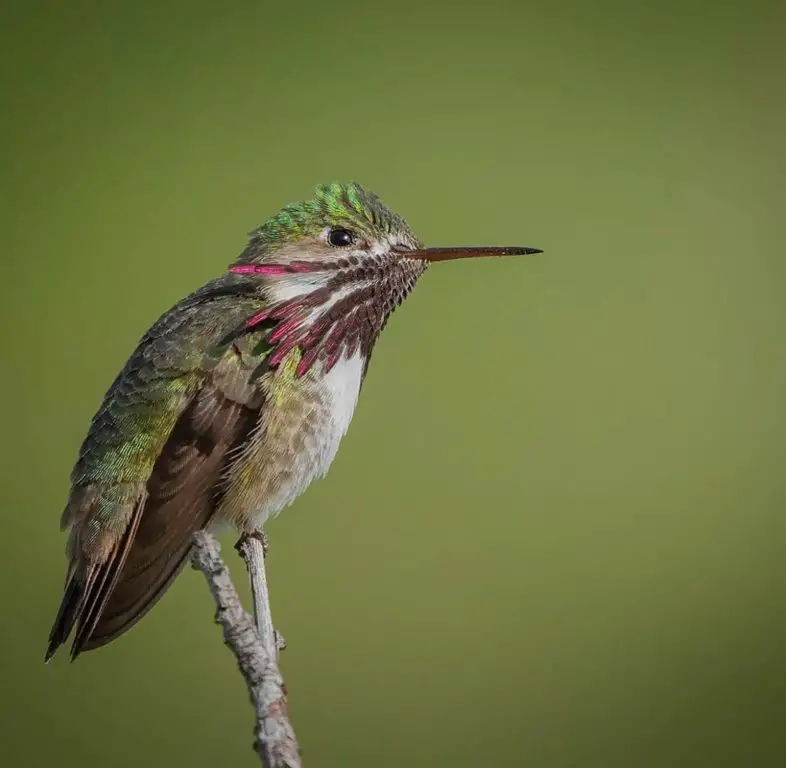
Photo by: sony_alpha_male
Note: His bright throat feathers are slowly coming in.
Baby Calliope hummingbirds are easily identified by their white fluffy feathers near their bottom that will disappear as they age.
Like many hummingbirds, Calliopes communicate not just by their song, but also by manipulating their feathers during flight to make different buzzing noises that act as a form of language and communication.
When a female is quietly perched, the male will passionately fly back and forth and engage in a “U” shaped courtship display to gain her attention. During his presentation, the male hummingbird will produce a vocal serenade while swinging his body from side to side in front of the female.
See my article: Hummingbird Dance: 5 Interpretive Explanations
Male Calliope hummingbirds establish a breeding territory and mate with every available female hummingbird that accepts his courtship.
They hybridize and readily crossbreed with other hummingbird species, such as the Costa’s hummingbird.
During nest construction, the female Calliope chooses the tops of pine cones as her building site. She will also dismantle nests from previous seasons and recycle them in her new nest along with stealing materials from the nests of other birds in order to construct her own.
Therefore, female Calliopes are often chased and attacked by larger and more aggressive hummingbirds such as Allen’s and Rufous hummingbirds. To avoid these attacks, the Calliope maintains a relatively low profile in comparison to other species.
Calliope hummingbirds are the smallest long-distance migratory bird in the world. Their migratory patterns mimic Rufous hummingbirds with spring migration. During northbound spring migration, they pass through the Pacific Flyways.
On their southbound journey in the fall, they pass through the Pacific and Rocky Mountain Flyways towards their wintering destination in Mexico.
See my article: Hummingbird Migration in Pennsylvania
Because Calliope hummingbirds have a more restricted wintering range than most hummingbirds, they are particularly vulnerable to habitat loss and natural disasters, such as climate change and wildfires.
During a capture and release banding operation in Idaho, the oldest living recorded female Calliope hummingbird was 8 years and 11 months old when she was captured twice, once in 2007 and again in 2014.
See my article: 3 Reasons Why Hummingbirds Are Banded
BLACK-CHINNED HUMMINGBIRD – (Archilochus alexandri)
Conservation Status: Least concerned
Kingdom: Animalia
Phylum: Chordata
Class: Aves
Order: Apodiformes
Family: Trochilidae
Genus: Archilochus
Species: A. alexandri
The Black-chinned hummingbird is one of six vagrant hummingbirds that are rare to see in Pennsylvania. The others include Allen’s, Anna’s, Bahama Woodstar, Calliope, Ruby-throated, and Rufous hummingbirds.
Black-chinned hummingbirds are a migrating species and seen mainly in the Western United States.
On average, out of 10,000 hummingbird sightings in Pennsylvania, 7 will be of the Black-chinned hummingbird. Out of all hummingbird sightings in Pennsylvania, 0.07% will be Black-chinned hummingbirds.
These limited sightings of Black-chinned hummingbird sightings in Pennsylvania are concentrated in the Lewisburg, Stroudsburg, and Trenton areas as of this article’s posting date.
See current Pennsylvania Black-chinned sightings map
The Black-chinned hummingbird’s scientific name is in commemoration of Dr. Alexandre, a French doctor who was the first to discover the species in Mexico.
Male Black-chinned hummingbirds are identified by their royal purple gorget, showing a small glimmer of color right near the neckline like a buttoned-up shirt. Since the male purple gorget or throat color is minimal, at times they can appear to look all black. They have metallic green on their backs and flanks with white on their underbelly. Their dark tail is forked and their bill is black. Their size is 3.25 inches to 3.5 inches in length and weigh 2.8-5.6 grams.
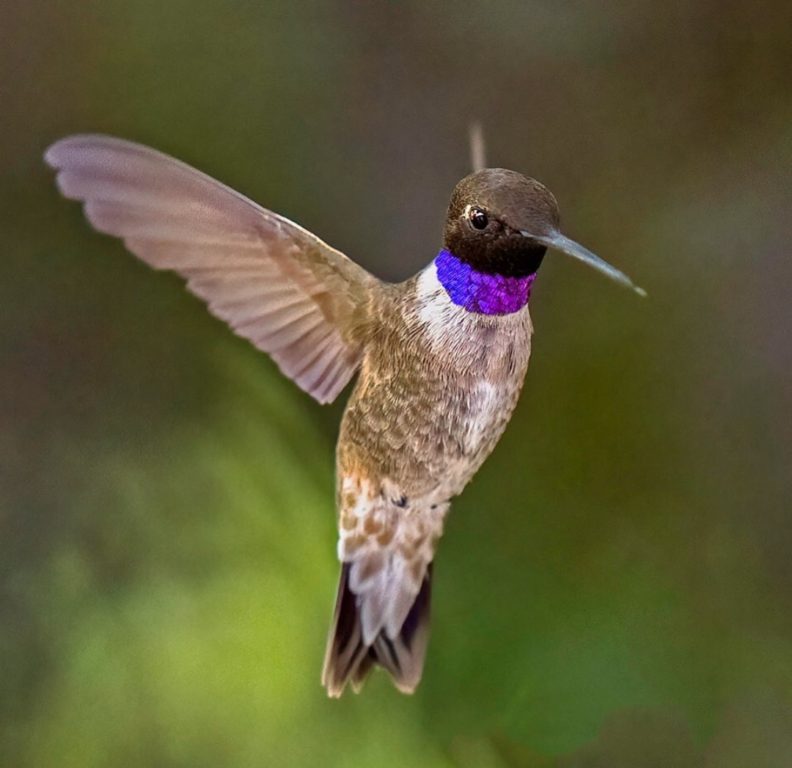
Photo by: sony_alpha_male

Photo by: hummingbirdsbysuprise

Photo by: bird.whisperer
Female Black-chinned hummingbirds do not have a gorget or iridescent feathers and are less vibrant than the males. They have a white underbelly and a dark rounded tail with white tips and beige margins on the dorsal feathers that turn dark black as they mature. Their head and back reflect the dull metallic marbled colors of beige, greens, whites, yellow-green, and dark browns, looking similar to the scales found on a snake.

Photo by: hummingbirdsbysuprise
Black-chinned hummingbirds breed east of the Cascade mountain range. They are known to make their nests near larger more active bird nests, reducing the chance of predators around the nest by using a decoy strategy.
Juvenile Black-chinned hummingbirds, both male, and female look more like adult females until they are differentiated as the male begins to acquire the iridescent feathers that are typical of this species of hummingbird.
Baby Black-chinned hummingbirds are easily identified by their white fluffy feathers near their bottom that will disappear as they age.
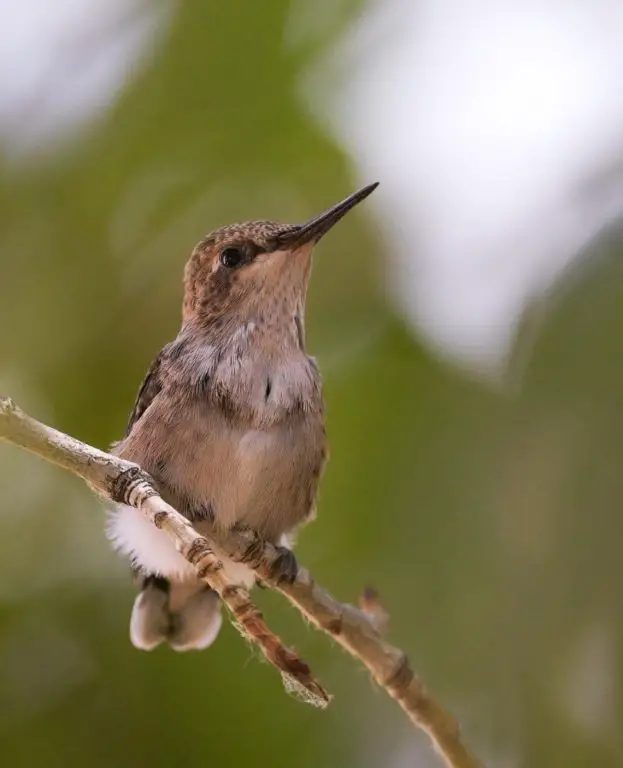
Photo by: bird.whisperer
Black-chinned hummingbirds have the smallest known genetic material of all living vertebrates or mammals. Because of their small size, they are at risk of being preyed upon by larger insect-eating birds.
See my article: 10 Common Things That Kill Hummingbirds
Hummingbirds are extremely territorial and can come across as being the meanest sheriff in town, especially when defending “their” feeders. They will fight over territory to protect nectar sources full of hummingbird-friendly flowering plants.
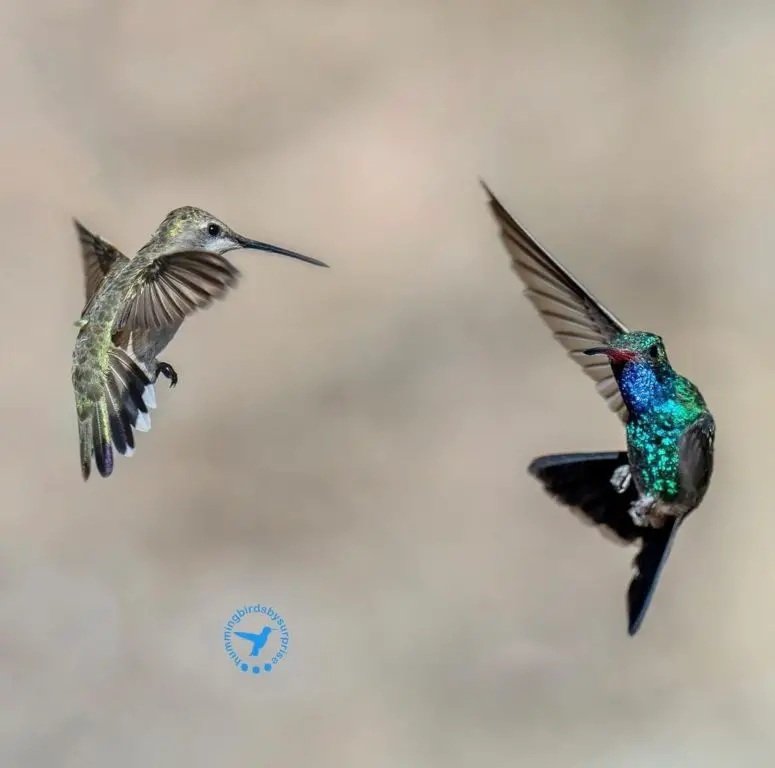
Photo by: hummingbirdsbysuprise
See my article: Why Hummingbirds Chase Each Other: Is it Friend or Foe?
While typically a territorial species, if Black-chinned hummingbirds find themselves in an area with a large population of hummingbirds and food sources, their territorial behavior reduces, and they will play nice and share.
They hybridize and readily crossbreed with other hummingbird species, such as the Anna’s and Costa’s hummingbird. Black-chinned hummingbirds can live up to 10 years, which is extremely long in comparison to other birds and animals of similar size.
During a capture and release banding operation in Texas, the oldest living recorded female Black-chinned hummingbird was 11 years and 2 months old.
See my article: 3 Reasons Why Hummingbirds Are Banded
BAHAMA WOODSTAR HUMMINGBIRD- (Calliphlox evelynae)
Conservation Status: Least concerned
Kingdom: Animalia
Phylum: Chordata
Class: Aves
Order: Apodiformes
Family: Trochilidae
Genus: Nesophlox
Species: N. evelynae
Bahama Woodstar hummingbirds are a Caribbean native predominantly found in the Turks and Caicos Islands, the Bahamas, and scarcely in the southern half of Florida making them rare in Pennsylvania.
On average, only 1 Bahama Woodstar hummingbird will be seen out of 27,000 hummingbird sightings in Pennsylvania
Out of all hummingbird sightings in Pennsylvania, 0.004% will be Bahama Woodstar hummingbirds.
These limited sightings of Bahama Woodstar hummingbird sightings in Pennsylvania are concentrated just north of the Lancaster area as of this article’s posting date.
See current Pennsylvania Bahama Woodstar sightings map
Male Bahama Woodstar hummingbirds feature a rose-purple gorget defined by a white collar under the gorget. During the breeding season, the gorget is vibrant. However, once the breeding season is over these male hummingbirds molt and shed their vibrant gorget feathers turning it a light dull gray making them look similar to females. This process is known as “eclipse plumage”.
Their wings are brown and the tail is deeply forked and black. Bahama Woodstar hummingbirds display a mottled olive green and tan color that starts from the head and flows down the back. They have a light tan belly with white flanks. Their beaks are medium in length and slightly curved. Their size ranges from 3.1-3.7 inches in length and weighs 2.4-3.0 grams.
Female Bahama Woodstar hummingbirds’ plumage is not as vibrant in color and the tails are rounded. They don’t have the white collar as seen in the males.
Juvenile Bahama Woodstar hummingbirds, both male and female, look more like adult females until they are differentiated as the male begins to acquire the iridescent feathers that are typical of this species of hummingbird.
Baby Bahama Woodstar hummingbirds are easily identified by their white fluffy feathers near their bottom that will disappear as they age.
See pictures and hear the sounds of Bahama Woodstar hummingbirds
Is Pennsylvania Attractive to Hummingbirds?
Pennsylvania attracts hummingbirds because of its humid continental climate, its diversity in elevation from zero feet above sea level at the Delaware river to 3,213 feet at Mount Davis, forests that cover 5% of the state, agriculture land covering 62% of the state, and rainfall annually of more than 50 inches.
On average, Pennsylvania daytime temperatures are above freezing all 12 months of the year.
Only December, January, and February drop below freezing at night with the night-time average being 30.6, 25.5, and 27.5 degrees Fahrenheit respectively.
See my article: Should I keep My Hummingbird Feeders Out During the Winter
See my article: 11 DIY Ways To Keep Hummingbird Nectar From Freezing
The hottest months of the year in Pennsylvania are June, July, and August, with daytime high temperatures of 80.6, 85.5, and 84.0 degrees Fahrenheit respectively, however, Pennsylvania’s all-time high was set in 1936 at 111 degrees Fahrenheit, oddly enough, in Phoenixville.
See my article: How to Cool Hummingbird Nectar in Hot Weather
According to the United States Dept of Agriculture, Pennsylvania has 16.8 million acres of Forest representing about 36% of all land mass in Pennsylvania.
Another 28.6 million acres, 62% of all Pennsylvania’s land mass is dedicated to agriculture, according to Penn State.
Hummingbirds play an important part in pollination.
Hummingbirds are the second most important pollinator, only exceeded in importance to the honeybee.
This combination of climate and land use makes Pennsylvania a good choice for some hummingbirds, especially the Ruby-throated hummingbird, the species of hummingbirds that dominate the Pennsylvania landscape.
See my article: Hummingbird Migration in Pennsylvania
Check out my other posts on Hummingbird Questions
Happy Hummingbird Watching!
Backyard Visitors is a participant in the Amazon Services LLC Associates Program, an affiliate advertising program designed to provide a means for sites to earn advertising fees by advertising and linking to Amazon.com. We also participate in other affiliate programs which compensate us for referring traffic.

